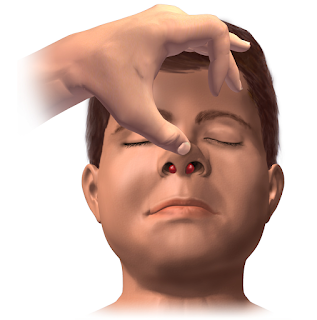Septal deviation is a condition when the dividing wall between the two nostrils is tilted or crooked. This condition can occur due to abnormalities from birth, or due to an injury to the nose. In severe conditions, septal deviation can cause frequent nasal congestion and recurrent sinusitis. The nasal septum or nasal septum is the cartilage that separates the left and right nostrils. This boundary bone is covered by a layer of mucus (mucosa) which is rich in blood vessels.
 |
| Septal deviation, Causes, Diagnosis, Treatment, Prevention, Complications |
Normally, the nasal septum divides the two nostrils equally. However, in septal deviation, this limiting bone does not divide the two openings equally so that one of them becomes smaller.
Causes of Septal Deviation
Septal deviation can be caused by several factors, namely:
Congenital abnormalities
In some cases, septal deviation appears from birth due to poor growth of the nasal septum while in the womb.
Nose injury
An injury to the nose can make the nasal septum move from its normal position. In babies, injuries to the nose can occur during delivery. Meanwhile, in children and adults, injuries to the nose can occur due to falls, collisions, accidents while driving, or injuries during sports.
Apart from the two factors above, septal deviation can also occur due to long-term (chronic) infections in the nasal cavity. This is because swelling and irritation from allergic rhinitis or infection can make one nostril narrow, making the nasal septum look crooked.
It should be noted that increasing age can also affect the structure of the nose. Therefore, if someone has a septal deviation, the condition can get worse as they get older.
Septal Deviation Symptoms
Mild septal deviation generally does not cause symptoms so that the sufferer is often not aware of it. However, if severe, septal deviation can block one nostril and block airflow in that nostril.
The following are some other symptoms of septal deviation that can appear:
- Nasal congestion
- Frequent nosebleeds
- Headache or pain in the facial area
- Difficulty breathing through the nose
- Snoring sleep
- Hard to sleep
- Recurrent colds and sinusitis
When to see a doctor
Check with your doctor if you have a stuffy nose that doesn't get better, persistent nosebleeds, or recurring sinusitis. Immediately see a doctor if these symptoms interfere with sleep and daily activities.
Septal deviation diagnosis
Diagnosis of septal deviation begins with a question and answer about the symptoms experienced by the patient. After that, the doctor will do an examination to see the condition of the nose and outer nostrils.
To examine the nostrils in more depth, the doctor will use a flashlight and special tools to hold the nasal cavities open. Next, the doctor will insert a small tube with a camera (nasal endoscope) into the nostrils.
Generally, doctors can make a diagnosis of septal deviation through the above examinations. However, if needed, the doctor will suggest a CT scan of the sinuses to see the structure of the patient's nose and sinuses more clearly.
Septal Deviation Treatment
Septal deviation treatment methods depend on the severity of the condition. The following are some methods that can be done:
Drugs
In mild septal deviation, the doctor can give several medicines to relieve the symptoms that appear. Medicines that can be given are:
- Decongestant tablets or nasal sprays, to reduce swelling in the nasal passages and relieve nasal congestion so breathing becomes easier
- Antihistamine tablets, to relieve sneezing and runny nose, especially if triggered by allergies
- Nasal sprays containing corticosteroids, to relieve swelling in the nasal passages
Operation
If the patient suffers from severe septal deviation or medication is not effective in treating symptoms, the doctor will perform a septoplasty. Septoplasty aims to return the septum to its normal position.
If the septal deviation is severe enough and accompanied by a change in the shape of the nose, the doctor will also combine the septoplasty procedure with nose reconstructive surgery (rhinoplasty).
Septal Deviation Complications
If left untreated, severe septal deviation can cause the following complications:
- Chronic sinusitis
- Dry mouth due to breathing through the mouth, because it is difficult to breathe through the nose
- Sleep disorders
Prevention of Septal Deviation
As previously explained, some cases of septal deviation can occur from birth, so they cannot be prevented. Meanwhile, if septal deviation does not occur from birth, there are several things that can be done to reduce the risk of this condition, namely:
- Be careful and use personal protective equipment, such as a helmet, when working, driving or playing sports
- Wash your hands regularly with soap and running water to prevent coughing and colds
- Avoiding allergy-triggering substances, to prevent allergic rhinitis
Related Searches:
- septal deviation,
- severe septal deviation,
- nasal septal deviation,
- nasal septal deviation treatment,
- mild septal deviation,
- caudal septal deviation,
- septal deviation icd 10,
- left septal deviation,
- nasal septal deviation icd 10,
- leftward nasal septal deviation,


